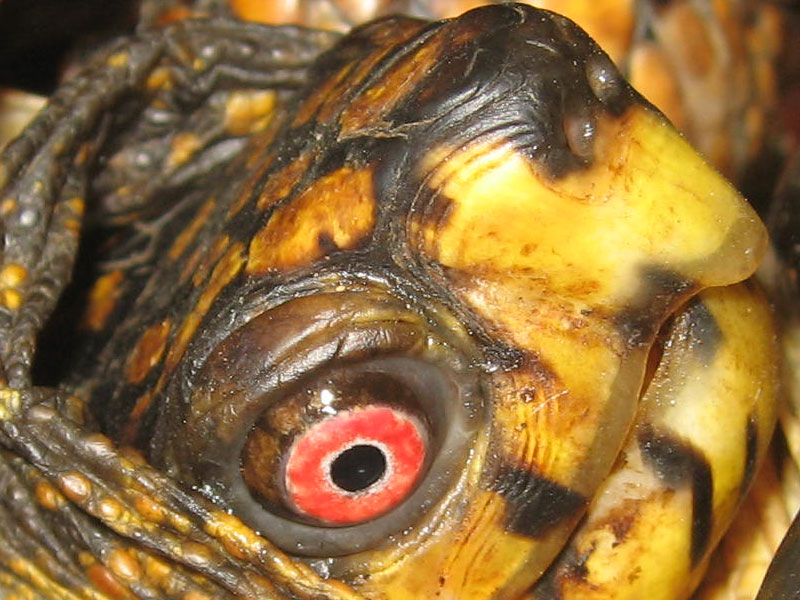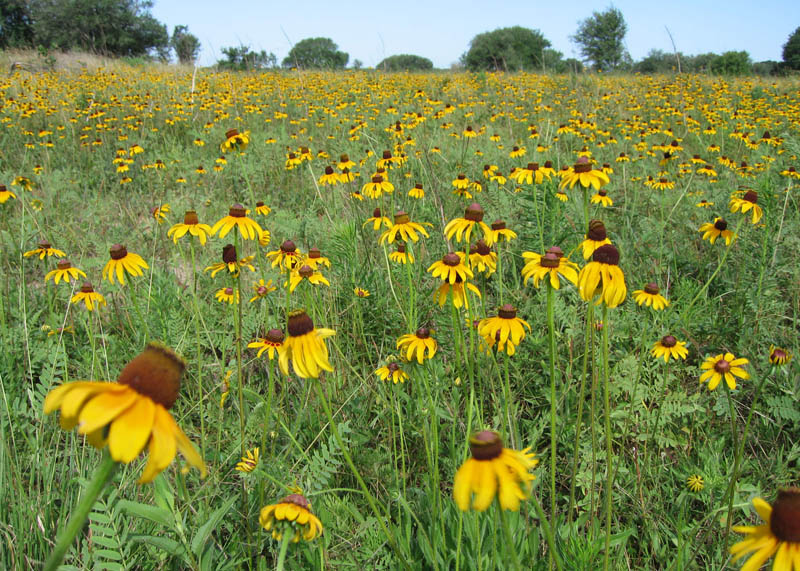
Monday, December 31, 2007
Friday, December 28, 2007
Architectural Dislike #7: Long Walks from Green to Tee
 The two most important parts of designing and building a golf course are starting (the routing plan) and finishing. A good routing almost always keeps the holes close to each other with short green to tee walks. It provides an intimate setting and facilitates keeping a continuity while playing. The time to reflect and enjoy ones time on the course is when walking from the hitting spot to where the ball comes to rest.
The two most important parts of designing and building a golf course are starting (the routing plan) and finishing. A good routing almost always keeps the holes close to each other with short green to tee walks. It provides an intimate setting and facilitates keeping a continuity while playing. The time to reflect and enjoy ones time on the course is when walking from the hitting spot to where the ball comes to rest.The above picture is from a very memorable round I played a few years ago. I highlighted the ride from a green to the next tee. I say ride as it is an impossible course to walk. It was incredible the number of long walks on the course, which in great part lead to this being one of the worst courses I've ever seen.
Wolf Point's total walk from the first tee to the 18th green is approximately 4.3 miles. The walks from green to tee are miniscule. For reference the above pictured course's walk would have been above 7 miles - if one was allowed to walk.
Friday, December 21, 2007
Architectural Dislike #6: Golf Stuff
 I sure wish there was no stuff on a golf course. There isn't at Wolf Point -- every visible outside element takes me further away from the game. I vividly recall once using a ball washer as a target on one of the finest holes in the world. It helped me hit a great shot but left an aftertaste. It has been a goal to avoid as many visual distractions as possible: grass lines, trash cans, cart paths, irrigation satellites, tee markers, the pump station, rakes and ball washers especially.
I sure wish there was no stuff on a golf course. There isn't at Wolf Point -- every visible outside element takes me further away from the game. I vividly recall once using a ball washer as a target on one of the finest holes in the world. It helped me hit a great shot but left an aftertaste. It has been a goal to avoid as many visual distractions as possible: grass lines, trash cans, cart paths, irrigation satellites, tee markers, the pump station, rakes and ball washers especially.Thursday, December 20, 2007
Architectural Dislike #5: Small Ponds
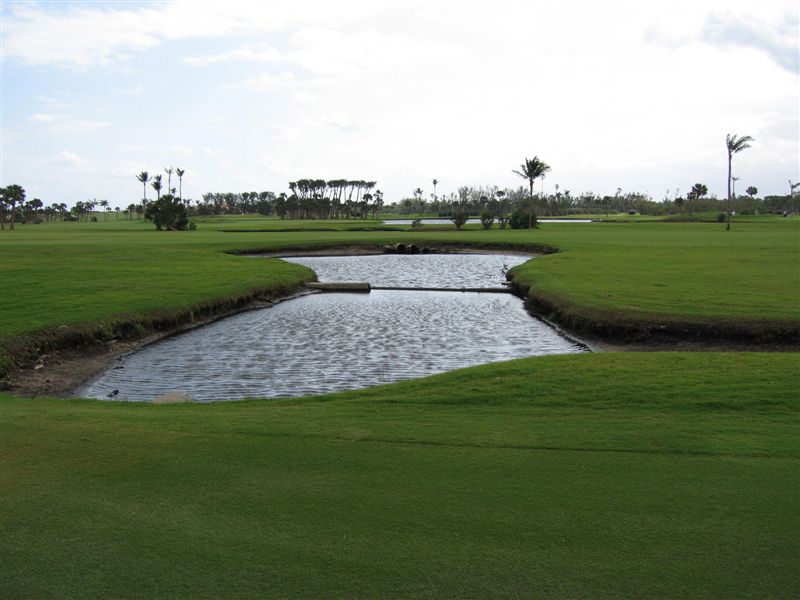 Ponds as small as a bunker! I also mean the ones a little bigger too. I've seen lots of those, especially in Texas and Florida. Yes they are used as collection spots to drain to and then later overflow into larger areas. Yes they can be needed on flatter sites. But they don't have to be directly in play. Only one time have I seen a small pond look bigger - due to the geometry and the plantings.
Ponds as small as a bunker! I also mean the ones a little bigger too. I've seen lots of those, especially in Texas and Florida. Yes they are used as collection spots to drain to and then later overflow into larger areas. Yes they can be needed on flatter sites. But they don't have to be directly in play. Only one time have I seen a small pond look bigger - due to the geometry and the plantings.There is not mistaking what we created at Wolf Point - it is a big pond (13 acres) and a setting in itself not just trying to add to the existing setting. It is very peaceful watching the choppy water and feeling the breeze at the end of a long day.
Wednesday, December 19, 2007
With my 100th post comes my first blog award...
 The following quote is from an esteemed friend at Golf Club Atlas.
The following quote is from an esteemed friend at Golf Club Atlas. Golf Blog of the year
The Naffy goes to-------- >Tie (Ian Andrew's Caddy Shack and Mike Nuzzo)
People who read blogs, really don't like reading. In reality I think they just require visual stimulation first. As a rule, I stay away from blogs full of self promotion or those that are trying to highlight themselves. It is part of the reason I don't have a blog, why listen to a hardbag winge? Ian Andrew is a bloggist who is not afraid to shoot from the lip and moreover he's a wonderful writer and golf architect. Ian's lists and the rationale behind them are fodder for many a discussion over a few beers. If I've learned anything from him, it is this--Truly it is heinous to rank anything in the golf architecture business but a necessary evil that I cannot like Jessica Alba keep my eyes off of. His compilations are superb.
Yet, I will make bold to say, Ian cannot share the Naffy alone. Mike Nuzzo's tag is a horseshoe perhaps not because he works out of Texas but because just knowing him is good luck. Mike can you feng shui my house? I have followed his new project which is the subject of his blog daily. It truly is a wonderful look into what it takes to build a course on a daily basis. If you ever wanted to know how difficult and thrilling it can be at the same time with some one who is on site every day, then read Mike's blog.
Sunday, December 16, 2007
Architectural Dislike #4 : Swoopy
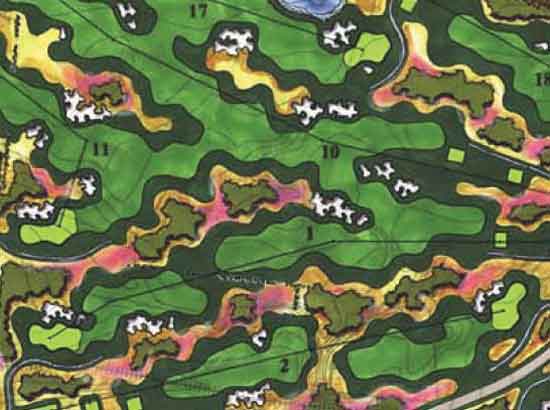 I hate swoopy. Swoopy is the term I use for a regular wavey shape. Swoopy fairway lines are often used to create artificial interest in fairways where there is no interest. Or the grassing lines are made swoopy to go around the artificial containment mounding. Greens are made swoopy for the same reasons too, and bunkers while usually a different swoop frequency are still swoop to me. The picture above has all the swoops swooped into one.
I hate swoopy. Swoopy is the term I use for a regular wavey shape. Swoopy fairway lines are often used to create artificial interest in fairways where there is no interest. Or the grassing lines are made swoopy to go around the artificial containment mounding. Greens are made swoopy for the same reasons too, and bunkers while usually a different swoop frequency are still swoop to me. The picture above has all the swoops swooped into one.There is no swoop at Wolf Point. The interest comes in the form of three dimensional irregular movement - rumples and waves.
Friday, December 14, 2007
Who's There
Tuesday, December 11, 2007
The 6th Hole - A Found Golf Hole
As promised - Don Mahaffey is today's guest writer:
 One of my favorite holes on our golf course is the 6th hole. I love this hole because it is so subtle and so simple -- and because it required very little work -- I already had enough work to do! It is a par 3 that can play from 210 to 135 yards. It plays almost due south. The prevailing wind is from the south east and is into the player at about the 10 o’clock angle.
One of my favorite holes on our golf course is the 6th hole. I love this hole because it is so subtle and so simple -- and because it required very little work -- I already had enough work to do! It is a par 3 that can play from 210 to 135 yards. It plays almost due south. The prevailing wind is from the south east and is into the player at about the 10 o’clock angle.
By far the hardest part about building this hole was having the courage to just leave it alone. We debated this a lot as the original plan called for a couple of bunkers to be added and shaped. But as we cleared the few trees and light brush in the area it became even more obvious that very little work was required for this to be a fine golf hole. The hole has a creek hazard running up the entire left side and behind the left portion of the green. Since the lay of the land is sloping right to left, the creek is very much in play and additional hazards were not needed. The green slopes hard to the left and the back half falls away to the creek behind.
Mike has his own modern architectural dislikes, and I don’t have the patience to come up with 10 at this time, but chief among mine is the fact that I believe most architects would have felt the need to “spruce up” this hole, if only so it photographed better. Or they feel the need to “copy” holes that were built over a century ago by architects who worked with the ground they were given. If we need to copy anything from the past, we should be looking at the processes they used to create great holes with the land they had to work with. Our 6th hole represents the type of architecture that I love, and find lacking in most modern work; simple, subtle, yet very challenging. I’m very proud of the work (or lack of) we did to create this hole.
 One of my favorite holes on our golf course is the 6th hole. I love this hole because it is so subtle and so simple -- and because it required very little work -- I already had enough work to do! It is a par 3 that can play from 210 to 135 yards. It plays almost due south. The prevailing wind is from the south east and is into the player at about the 10 o’clock angle.
One of my favorite holes on our golf course is the 6th hole. I love this hole because it is so subtle and so simple -- and because it required very little work -- I already had enough work to do! It is a par 3 that can play from 210 to 135 yards. It plays almost due south. The prevailing wind is from the south east and is into the player at about the 10 o’clock angle.By far the hardest part about building this hole was having the courage to just leave it alone. We debated this a lot as the original plan called for a couple of bunkers to be added and shaped. But as we cleared the few trees and light brush in the area it became even more obvious that very little work was required for this to be a fine golf hole. The hole has a creek hazard running up the entire left side and behind the left portion of the green. Since the lay of the land is sloping right to left, the creek is very much in play and additional hazards were not needed. The green slopes hard to the left and the back half falls away to the creek behind.
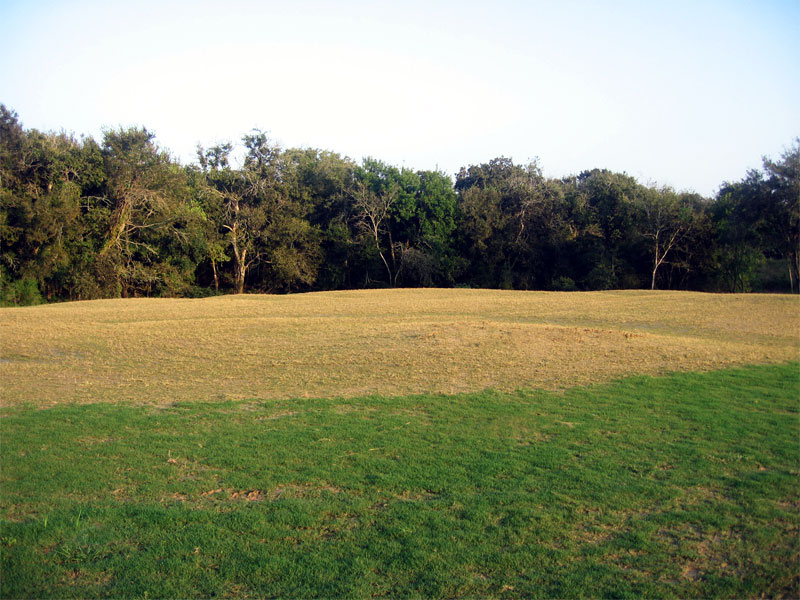
Mike has his own modern architectural dislikes, and I don’t have the patience to come up with 10 at this time, but chief among mine is the fact that I believe most architects would have felt the need to “spruce up” this hole, if only so it photographed better. Or they feel the need to “copy” holes that were built over a century ago by architects who worked with the ground they were given. If we need to copy anything from the past, we should be looking at the processes they used to create great holes with the land they had to work with. Our 6th hole represents the type of architecture that I love, and find lacking in most modern work; simple, subtle, yet very challenging. I’m very proud of the work (or lack of) we did to create this hole.
Don Mahaffey
Golf Course Superintendent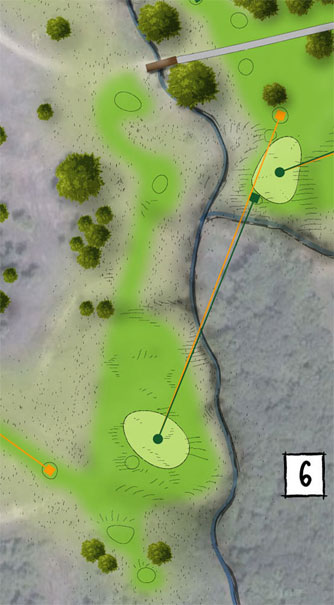
The 6th Hole - A Redan?
 I've seen and played several Redans*. "The Redan" at North Berwick, Chicago, Shore Acres, Shinnecock, NGLA, The Knoll, Pacific Dunes, Apache Stronghold and many other variants of varying quality (all those links are to aerials of the Redans - give 'em a click). The primary features are a green that runs away from the player with a fortress type bunker flanking the front and usually back of the green. None of the green complexes I listed above are completely similar, and frankly I don't think any of them look much like the original Redan.
I've seen and played several Redans*. "The Redan" at North Berwick, Chicago, Shore Acres, Shinnecock, NGLA, The Knoll, Pacific Dunes, Apache Stronghold and many other variants of varying quality (all those links are to aerials of the Redans - give 'em a click). The primary features are a green that runs away from the player with a fortress type bunker flanking the front and usually back of the green. None of the green complexes I listed above are completely similar, and frankly I don't think any of them look much like the original Redan.The above illustration is the original layout of the 6th hole at Wolf Point. I visualized this hole early on in the routing process. The green site was surrounded in the back by a drainage way and the creek protects the entire left side. I struggled whether to make it a "real" Redan or to have a similar strategy or not at all. Don would suggest to ignore the fact that there ever was a Redan and we'll just make the hole as good as we can. Tomorrow I'm going to have Don guest host and explain why the 6th is one of his favorites.
Earlier Holes Featured: 1 - 2 - 3 - 4 - 5 - 7 - 8 - 9 - 10 -11 - 12 - 13 - 14 - 15 .
*If you would like to read more about the history or the redan pick up the following book: The Evangelist of Golf by my friend George Bahto.Wednesday, December 5, 2007
December Sharp Sweet Dusk Air
 Tonight the course was so beautiful I decided to take a brief intermission from my top 10 and share. I was at a spot I haven't photographed before -- directly behind the 12th green looking across the 11th & 2nd fairways towards the 3rd green in the distance. It was a beautiful day today and I sat for a while in this spot and enjoyed our progress and the sharp sweek dusk air.
Tonight the course was so beautiful I decided to take a brief intermission from my top 10 and share. I was at a spot I haven't photographed before -- directly behind the 12th green looking across the 11th & 2nd fairways towards the 3rd green in the distance. It was a beautiful day today and I sat for a while in this spot and enjoyed our progress and the sharp sweek dusk air.
Tuesday, December 4, 2007
Architectural Dislike #3: Truncated Cone Tees
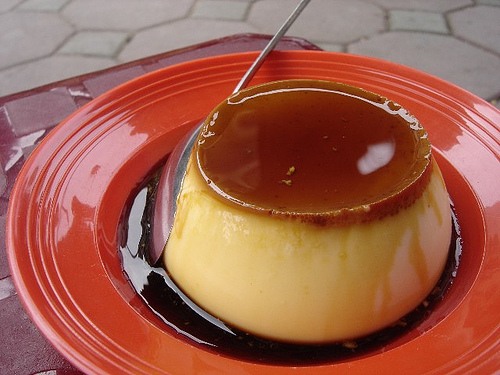 Again I'm a bit at a loss for a good picture to illustrate my dislike. I should note to collect more pictures of what I don't like to share with future clients and shapers. So in doing a web search for truncated cone - the above picture turned up - which is far more appetizing than as a tee.
Again I'm a bit at a loss for a good picture to illustrate my dislike. I should note to collect more pictures of what I don't like to share with future clients and shapers. So in doing a web search for truncated cone - the above picture turned up - which is far more appetizing than as a tee.There was and is a predisposition for the golfer to want to see the entire hole when on the tee. Hence the popularity of the elevated tee. I do not like when all 4 or 5 tees are separate land forms that all look like volcanoes. They are artificial looking, hard to climb, harder to maintain and build and they can posses a safety risk. I think their overuse is indicative of a poor routing plan. You won't see any of these at Wolf Point Club.
Pictured is a Crème brûlée.
Architectural Dislike #2: Bunkers that require mechanical rakes
 This picture is a twofer. I certainly don't like Mickey Mouse bunkers - and that was going to be a dislike, but looking at this picture got me thinking how I dislike bunkers that require a mechanical rake more. The long rake lines in the above picture are indicitive of the mechanical rake.
This picture is a twofer. I certainly don't like Mickey Mouse bunkers - and that was going to be a dislike, but looking at this picture got me thinking how I dislike bunkers that require a mechanical rake more. The long rake lines in the above picture are indicitive of the mechanical rake. The size drives up the maintenance costs by increased labor, equipment, fuel and increases the likelihood of damage.
This is a good example of where the golf hole could have looked great without any bunkers. It is competing with this naturally beautiful area.
The bunker seems to be artificially large to make room for the monkey and the excessive fingering.
Sunday, December 2, 2007
Top 10 Golf Architectural Dislikes - #1 The Flanked Driving Range

This post is a departure from the discussion of Wolf Point Club - the course this blog has been featuring - as there were several votes in the survey to the right. The idea was inspired by my friend Ian Andrew's architectural blog. This link is to a recent series that I thought was quite fun and informative - expressing dislikes is definately a common experience when visiting a course with another architect.
I am continuing his list with my dislikes - I made a list after his first day to see how they would compare - my list came out quite a bit differently.
#1 FLANKED DRIVING RANGE
A range flanked by two holes was the first dislike that came to mind. Unfortunately I didn't have any pictures, I really haven't been visiting any bad courses lately and never saw a need to photograph golf features I didn't like - I try to forget them. The above image is the first one I thought of, but I think there many examples.
A range can take up a lot of space. So much sometimes that is may be the primary item of concern when routing a course - NOT WOLF POINT. When the range is surrounded by containment mounding to separate the holes from the range, everything winds up looking like the driving range. Often it is 1 & 10 or 1 & 9 that wind up a complete bore. In general I don't find ranges to be worth the expense - I don't mind just taking one or two swings on the first tee to warm up. But if a range is best for the business plan or clients needs I like to see it on the perimeter of the property - used as a buffer for a bad view or parking.
Saturday, December 1, 2007
Thursday, November 29, 2007
1500 GPM - gallons per minute
 It can run higher (1800 gpm), but in the picture the pump station is flowing 1493 gallons per minute at 98 psi. The lower the pressure the more efficient. It isn't uncommon to have pumps running at 125+ psi and higher. We do not have to traverse any mountains.
It can run higher (1800 gpm), but in the picture the pump station is flowing 1493 gallons per minute at 98 psi. The lower the pressure the more efficient. It isn't uncommon to have pumps running at 125+ psi and higher. We do not have to traverse any mountains.The demands of water at grow-in are the greatest and what the pump station is often designed around. We've had a very gradual grow-in and do have quite a bit of flexability for our regular watering regime - which translates to a low concern for the demand on the pumps -- and the lake is pleanty big.
Wednesday, November 28, 2007
Installing the Pump
 What is long and blue and has a head and bowls? The above photo shows the installation of one of three pumps into the wet well. The long blue item is the pump -- the motor will sit on top once installed. The round things are called the bowls and each one has an impeller inside. It gets lowered into the well up to the flange and gets bolted to the green base that sits above the hole from the pictures earlier this week. The water exits through the discharge head and passes through the filters (the red horizontal component). The filtered water then merily passes along the network of pipes until it exits through a rotor or sprinkler.
What is long and blue and has a head and bowls? The above photo shows the installation of one of three pumps into the wet well. The long blue item is the pump -- the motor will sit on top once installed. The round things are called the bowls and each one has an impeller inside. It gets lowered into the well up to the flange and gets bolted to the green base that sits above the hole from the pictures earlier this week. The water exits through the discharge head and passes through the filters (the red horizontal component). The filtered water then merily passes along the network of pipes until it exits through a rotor or sprinkler.
Tuesday, November 27, 2007
Irrigation Wet Well almost finished
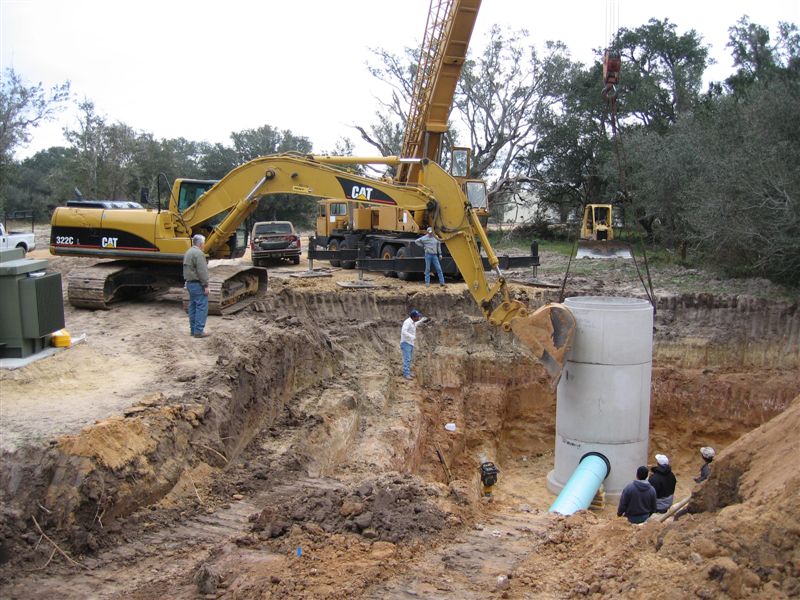 Taking my cue from the survey at right (please share your opinion)... This picture was taken last winter, note the jackets. Here the crew is adding the third stage to the wet well. The lake is connected at the bottom and the pumps will sit on top of the hole and draw the water out and it is fed by the lake. Aside from the final structure being the Taj Mahal of pump houses, what I found most unique was where we had the pump station located. The picture below gives a hint.
Taking my cue from the survey at right (please share your opinion)... This picture was taken last winter, note the jackets. Here the crew is adding the third stage to the wet well. The lake is connected at the bottom and the pumps will sit on top of the hole and draw the water out and it is fed by the lake. Aside from the final structure being the Taj Mahal of pump houses, what I found most unique was where we had the pump station located. The picture below gives a hint. 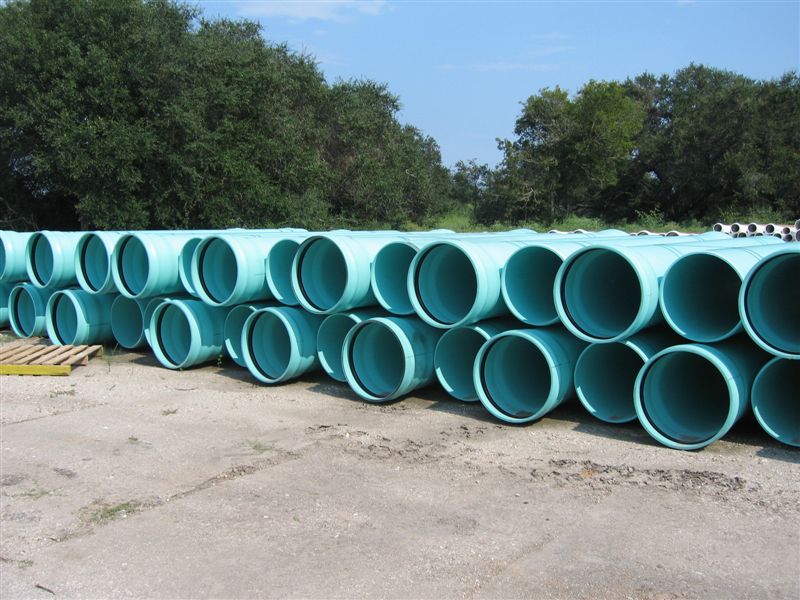 This 24" diameter pipe is what we used to connect the lake to the pump station. Each piece is 14' long, and not all are shown. The unique part is that the pump is over 600' away from the lake -- hidden in the trees. We went to great lengths to hide everything that wasn't grass or a bunker. This link contains a picture from a previous post about our maintenance facility. The stone road passes through the two buildings and then heads to the pump station, which is near the end of the live oaks. If you look at the far left edge of the picture you will see the beginning of the lake -- 600 feet away. The cleaner unincumbered look was very much worth the effort. It is also much easier to get to the pump station from the maintenance facility, and it is on the way to the course so Don and the staff will easiliy be able to check on the pump throughout the day.
This 24" diameter pipe is what we used to connect the lake to the pump station. Each piece is 14' long, and not all are shown. The unique part is that the pump is over 600' away from the lake -- hidden in the trees. We went to great lengths to hide everything that wasn't grass or a bunker. This link contains a picture from a previous post about our maintenance facility. The stone road passes through the two buildings and then heads to the pump station, which is near the end of the live oaks. If you look at the far left edge of the picture you will see the beginning of the lake -- 600 feet away. The cleaner unincumbered look was very much worth the effort. It is also much easier to get to the pump station from the maintenance facility, and it is on the way to the course so Don and the staff will easiliy be able to check on the pump throughout the day.
Irrigation Crew starting the Wet Well
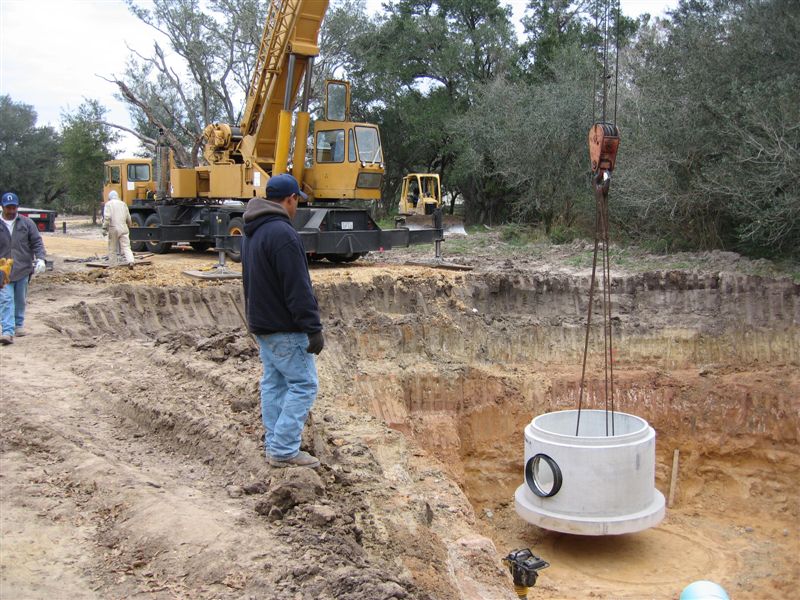 The crew is the Irrigation Crew, and yesterday's picture was the hole dug for the wet well. The hole is this large for safety reasons, the steps keep the walls from collapsing. It is this deep because it connects the bottom of the lake with the pump station. The opening in the concrete base attaches to the pipe in the lower portion of the picture which runs to the lake. I'll share a sketch and more details tomorrow.
The crew is the Irrigation Crew, and yesterday's picture was the hole dug for the wet well. The hole is this large for safety reasons, the steps keep the walls from collapsing. It is this deep because it connects the bottom of the lake with the pump station. The opening in the concrete base attaches to the pipe in the lower portion of the picture which runs to the lake. I'll share a sketch and more details tomorrow.Please fill out the survey, it will be open for two weeks.
Sunday, November 25, 2007
Where is this crew?
 In honor of adding a new item to the blog -- a coming soon section -- I'm asking two questions: Where is this crew? and What would you most like to see in the future?
In honor of adding a new item to the blog -- a coming soon section -- I'm asking two questions: Where is this crew? and What would you most like to see in the future?To the right I've listed some ideas that I will be posting for this blog -- some sooner -- some later. I'd say this picture falls under the catagory of "behind the scenes construction". Everything about this project has been interesting to me. I'd very much like some your opinions about what is interesting and what you'd like to see or learn. Please let me know what coming soon items would be of most interest and any other topics are welcome too. I added a survey above the coming soon section for easier feedback.
Cheers.
Friday, November 23, 2007
A Big Swale
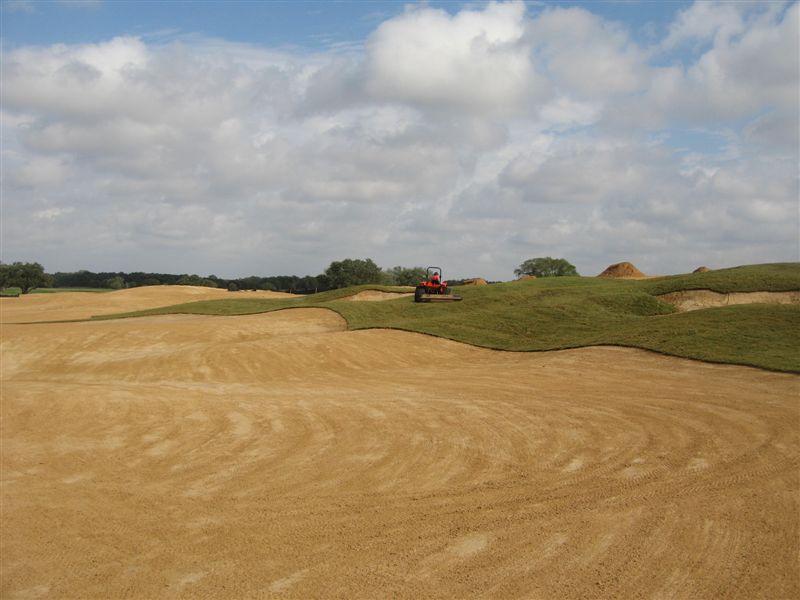 Please note the banner image above. The 8th & 18th greens are a large double green. They are separated by a large swale that can be seen in the above picture. I'm standing on the edge of the 8th green for the picture.
Please note the banner image above. The 8th & 18th greens are a large double green. They are separated by a large swale that can be seen in the above picture. I'm standing on the edge of the 8th green for the picture.Originally the greens weren't attached. During the refinement process, I kept shifting the 8th green towards the 9th tee, eventually it got so close to the 18th green it seemed natural to join the greens. They aren't attached by a thin mow strip -- a gimmick I've seen often -- but from above look like one giant green. The combined surfaces are approximately 13,000 sft.
This complex is going to be a blast to practice on and have short game matches through the evening hours.
Thursday, November 22, 2007
Happy Thanksgiving
Tuesday, November 20, 2007
15th Green getting greener and meaner
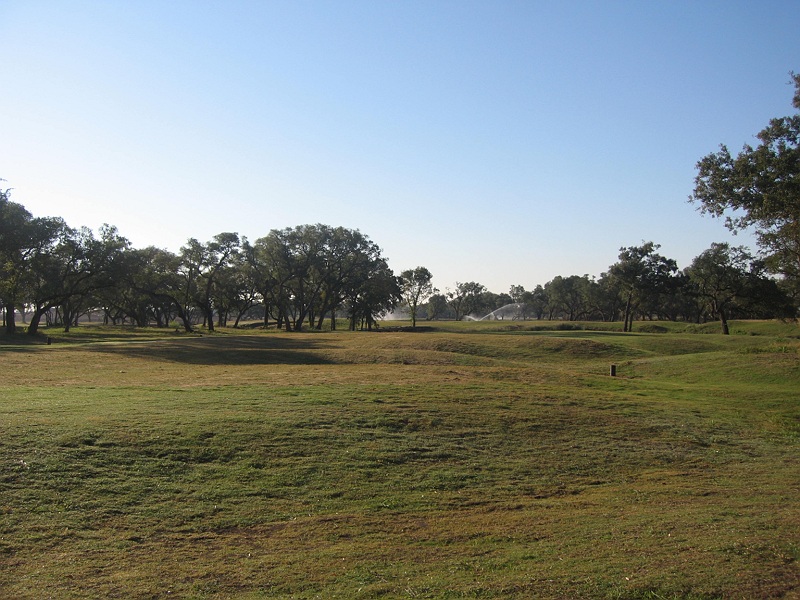 The above picture is of the 15th green - a short hole of 150 - 180 yards. I showed an image approximately 2 months ago of the finished (or polished) surface just prior to planting - see here. The camera is looking back towards the tee. Those ripples are 2-4 feet deep and both surround and bleed into the green. The putting surface is the largest on the course and its final shape won't be exact until we start mowing -- the green grass was planted into the surrounds as well. This should help minimize grassing lines, create tighter chipping areas, eliminate the need for a collar and provide flexibility for mowing. I've never seen a green like this one before. I love it.
The above picture is of the 15th green - a short hole of 150 - 180 yards. I showed an image approximately 2 months ago of the finished (or polished) surface just prior to planting - see here. The camera is looking back towards the tee. Those ripples are 2-4 feet deep and both surround and bleed into the green. The putting surface is the largest on the course and its final shape won't be exact until we start mowing -- the green grass was planted into the surrounds as well. This should help minimize grassing lines, create tighter chipping areas, eliminate the need for a collar and provide flexibility for mowing. I've never seen a green like this one before. I love it.
Monday, November 19, 2007
Mothra
 I thought this moth looked more like Snuffleupagus from the back. All the pictures featured on this blog have been taken with a Canon SD500 Elph. This one was with the macro setting.
I thought this moth looked more like Snuffleupagus from the back. All the pictures featured on this blog have been taken with a Canon SD500 Elph. This one was with the macro setting.
Thursday, November 15, 2007
The 13th From Above
 I thought the above plan view of the 13th would help explain the playability. It looks like there is a bit of room between the last bunker and the green, but that is only from above as the ground slopes downhill away from the bunker across the back of the green. The two bunkers are also built in a rather large land form -- if you hit the left side of the fairway, you will not be able to see a back pin. This hole is quite testing.
I thought the above plan view of the 13th would help explain the playability. It looks like there is a bit of room between the last bunker and the green, but that is only from above as the ground slopes downhill away from the bunker across the back of the green. The two bunkers are also built in a rather large land form -- if you hit the left side of the fairway, you will not be able to see a back pin. This hole is quite testing.
The 13th
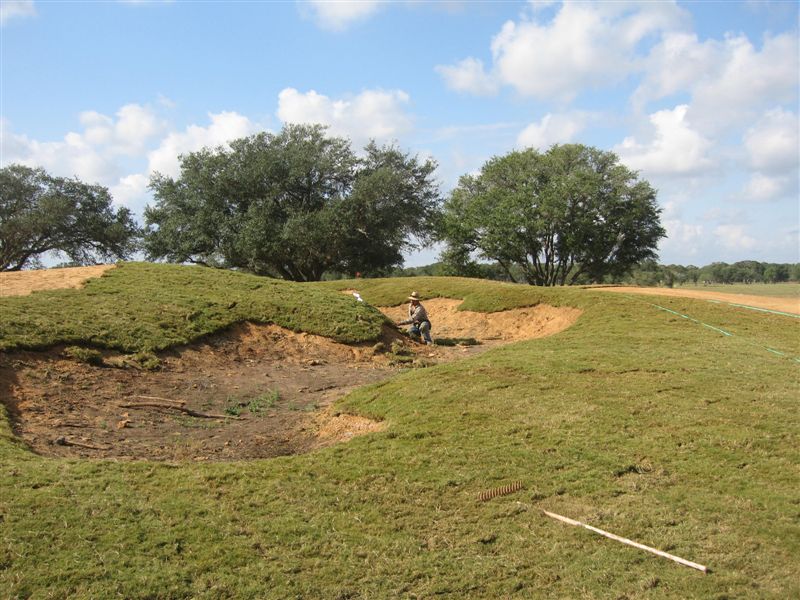 This is one of the bigger bunkers on the course -- although there is one bigger just a few yards away. The one pictured is nestled next to the 13th green -- the sand to the right of the bunker. It is the longest par 4 on the course -- pretty close to 500 yards depending on your tee -- it is also downwind. If the ball carries the bunker it may bound down to the green, or maybe a little long. You could always play to the right side of the fairway and not have to contend with the bunker -- depending on pin location.
This is one of the bigger bunkers on the course -- although there is one bigger just a few yards away. The one pictured is nestled next to the 13th green -- the sand to the right of the bunker. It is the longest par 4 on the course -- pretty close to 500 yards depending on your tee -- it is also downwind. If the ball carries the bunker it may bound down to the green, or maybe a little long. You could always play to the right side of the fairway and not have to contend with the bunker -- depending on pin location. You can see the two biggest bunkers on the course in the new banner image on top of this page. The one to the right is much nastier.
Earlier Holes Featured: 1 - 2 - 3 - 4 - 5 - 7 - 8 - 9 - 10 -11 - 12 - 14 - 15 .
Wednesday, November 14, 2007
Virescent Green Grass Growing In
 The above picture was taken of the 17th green. It is growing in very well. It is very exciting for me to see the changes in person each visit. We did a number of things quite differently with both the design and construction of the greens. Don mowed one of the greens yesterday - the 2nd. He said it was very large and took him a long time to mow. I'll tell a good story about the 2nd green when I get a picture of it looking good in the early morning light. It is a stunning green.
The above picture was taken of the 17th green. It is growing in very well. It is very exciting for me to see the changes in person each visit. We did a number of things quite differently with both the design and construction of the greens. Don mowed one of the greens yesterday - the 2nd. He said it was very large and took him a long time to mow. I'll tell a good story about the 2nd green when I get a picture of it looking good in the early morning light. It is a stunning green.Can you guess what type of grass this is?
Tuesday, November 13, 2007
Turfnet: The Newsletter
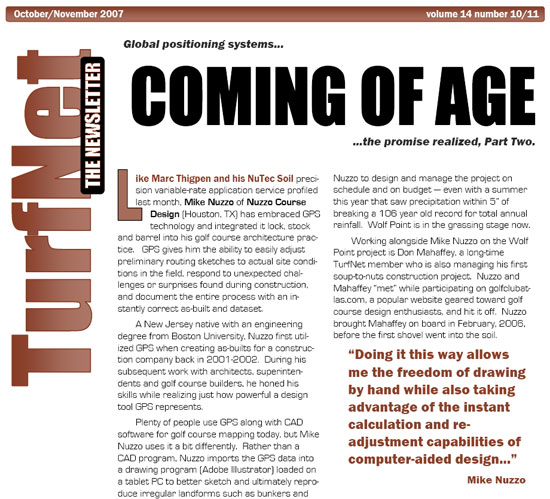
Recently Don and I were interviewed for an article in Turfnet: The Newsletter. The story was based on our use of GPS at our project. Please click if you'd like to read.
Monday, November 12, 2007
A new bunker....
 It has been many months since we've added, or removed, a bunker at the course. This week we are going to do one of each. I should say we may be replacing a tiny one with a bigger one. The above image is a sketch of what the proposed bunker will look like -- it is the one in the middle background. It looks good in the picture, and we'll see how it looks on the ground. Don wasn't looking for any new projects, but this one seems worth the small expense. This is the last area we are grassing -- it should be covered in sprigs and sod in a week or two.
It has been many months since we've added, or removed, a bunker at the course. This week we are going to do one of each. I should say we may be replacing a tiny one with a bigger one. The above image is a sketch of what the proposed bunker will look like -- it is the one in the middle background. It looks good in the picture, and we'll see how it looks on the ground. Don wasn't looking for any new projects, but this one seems worth the small expense. This is the last area we are grassing -- it should be covered in sprigs and sod in a week or two.
Friday, November 9, 2007
Armadillo
 The first armadillo I tracked on site was in the woods at the beginning of the project -- he had the advantage. This is the first one I saw on open ground -- my advantage. He was trotting along the 11th fairway. I learned that I am quite a bit faster than one -- my legs are longer, but he really didn't get the idea of a trap, or he knew I was just bluffing as he ran right by me. I also did learn that I'm not as fast as one when I'm trying to take a picture....
The first armadillo I tracked on site was in the woods at the beginning of the project -- he had the advantage. This is the first one I saw on open ground -- my advantage. He was trotting along the 11th fairway. I learned that I am quite a bit faster than one -- my legs are longer, but he really didn't get the idea of a trap, or he knew I was just bluffing as he ran right by me. I also did learn that I'm not as fast as one when I'm trying to take a picture....
Thursday, November 8, 2007
Wednesday, November 7, 2007
Sod

The cold season is upon us. It was a chilly 70 degrees today in Houston – a few warmer at the golf course. Don was determined to not use any sod at all for the grassing -- if we didn't have the rainiest year ever I'm sure he would have succeeded.
Sod is more costly as compared with spriging -- many modern courses sod the entire golf course at an expense between 1/2 & 1 Million US dollars (sprigging is a small fraction of that expense). When sprigging we also control the plant’s growing medium, either sand or sandy loam and all the nutrients – sod farms usually grow their grass in Texas gumbo soils – although our sod farm is top notch. The sprigs also get trained from an early age towards our final maintenance practices -- deep infrequent watering. (Golf turf bermuda grasses are either sprigged or sodded -- there are no seeds)
Well with only a bunch of grassing days left it was decided we'd need some sod to finish. It looks very much like it will be completely grassed by early next week -- "grassed out" is the industry term. I'm still rooting for an Indian Summer to keep everything growing.
In the picture above the crew is sodding around a drain basin. Water collects at the basin while watering -- it is too wet during the heavier demands of growing in the sprigs. The sod gives the area a great big head start. The black plastic pipe is the basin before trimming. The pipe is perforated to allow water in and keep soil infiltration to a minimum -- this one flows back into our irrigation lake. After sodding we trim it and install a small green color drain grate.
Congratulations everyone. I’ll be bringing a lot more beers on my next couple visits.
Monday, November 5, 2007
14 - Long
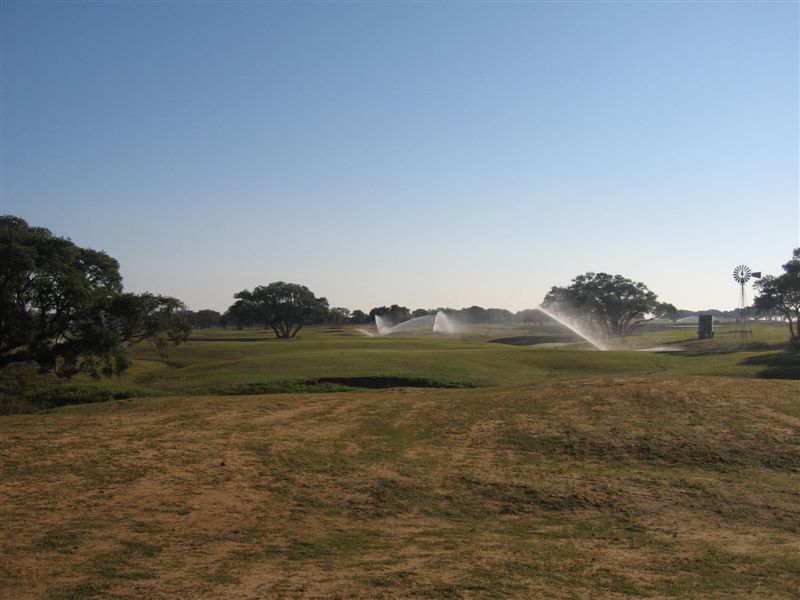 The 14th hole is a longish par 5. The tee shot has several bunkers in play, and not so in play. During the final phases of routing there was a beautiful live oak and I couldn't decide which way to go around the tree. Don suggested playing around it, we could always cut it down. I would have been uncomfortable with the idea, even though our client expressed his fondness of the live oaks on site from the very beginning. I think it is working out very well. We'll see how it plays very soon.
The 14th hole is a longish par 5. The tee shot has several bunkers in play, and not so in play. During the final phases of routing there was a beautiful live oak and I couldn't decide which way to go around the tree. Don suggested playing around it, we could always cut it down. I would have been uncomfortable with the idea, even though our client expressed his fondness of the live oaks on site from the very beginning. I think it is working out very well. We'll see how it plays very soon.My favorite aspect of the hole is the crowned fariway in the 2nd landing area -- just past the tree. It was a natural turtle-back bookended by two existing drainage swales.
You can also see the green in the foreground -- it is quite undulated. It is just after sprigging the green -- it will be rolled several times and take on a perfectly smooth appearance once cutting and rolling have become part of our regular maintenance.
Earlier Holes Featured: 1 - 2 - 3 - 4 - 5 - 7 - 8 - 9 - 10 - 12 - 11 - 15 .
Thursday, November 1, 2007
The weather is just fine for grassing
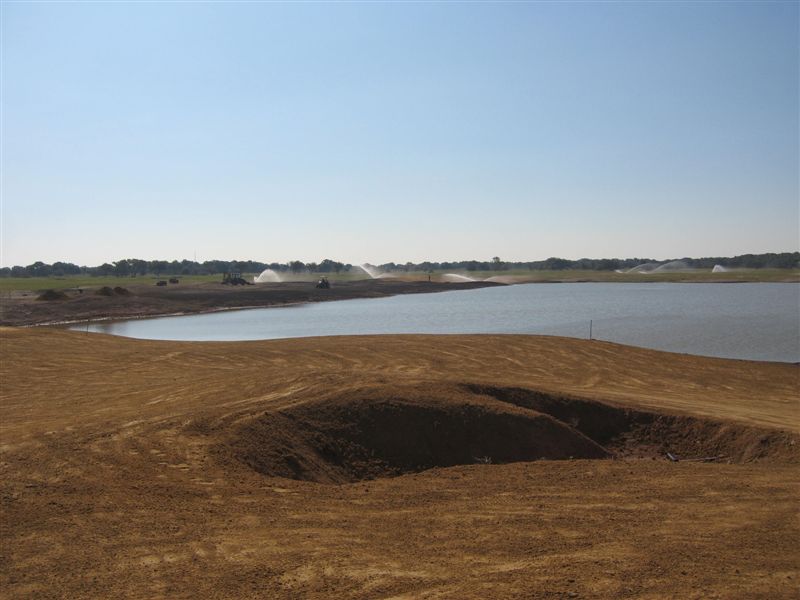 It was in the mid 80’s today. It looks like we are getting a good planting season this fall. It is a race now to the first frost. We are very, very close. In the picture above we are prepping the 10th hole, I’m shooting from over the 9th green side bunker -- which is also prepped.
It was in the mid 80’s today. It looks like we are getting a good planting season this fall. It is a race now to the first frost. We are very, very close. In the picture above we are prepping the 10th hole, I’m shooting from over the 9th green side bunker -- which is also prepped.It is incredible what Don is accomplishing with a crew 1/3 the typical size.
It is going to be verdant this spring -- I'm hoping for a hot winter.
Wednesday, October 31, 2007
Happy Halloween

We had a big take on candy tonight. Me and the family had a blast. We even found a haunted house in our neighborhood -- they had tons of decorations and scary monsters.
I very rarely eat candy but tonight I picked out a few of my favorites from the bounty.
The hershey candy above is fantastic, even if the name isn't the best. I don't know what the five things are, but the pretzel, penut butter and chocolate taste great together.
Monday, October 29, 2007
12th Hole -- short and surrounded by trouble
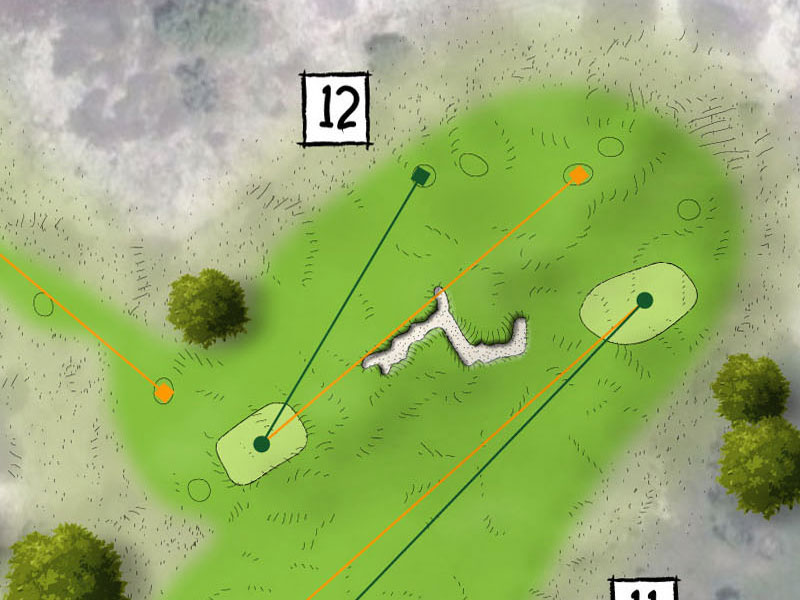 The 12th tee is elevated. The 12th Green is surrounded by trouble. There is only one bunker on the hole. The hole is at most 140 yards. The green slopes hard away and to the players right -- see above sketch. The hole plays with the prevailing wind. It is a very hard hole to photograph -- see below. The ideal ball flight is low and running. There is a pocket in front of the green that should act as a catchers mitt, and slow down the long aggressive ball, and propel the short ball forward. The bunker appears closer to the green than reality, and is severe. The green is also the smallest on the course. Have fun.
The 12th tee is elevated. The 12th Green is surrounded by trouble. There is only one bunker on the hole. The hole is at most 140 yards. The green slopes hard away and to the players right -- see above sketch. The hole plays with the prevailing wind. It is a very hard hole to photograph -- see below. The ideal ball flight is low and running. There is a pocket in front of the green that should act as a catchers mitt, and slow down the long aggressive ball, and propel the short ball forward. The bunker appears closer to the green than reality, and is severe. The green is also the smallest on the course. Have fun.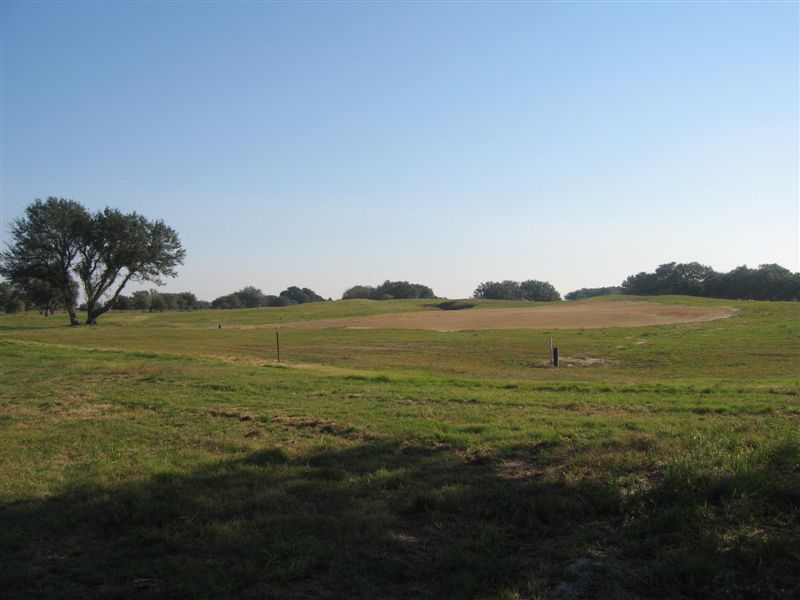 Looking back from beyond the green. It is tilted towards the camera.
Looking back from beyond the green. It is tilted towards the camera.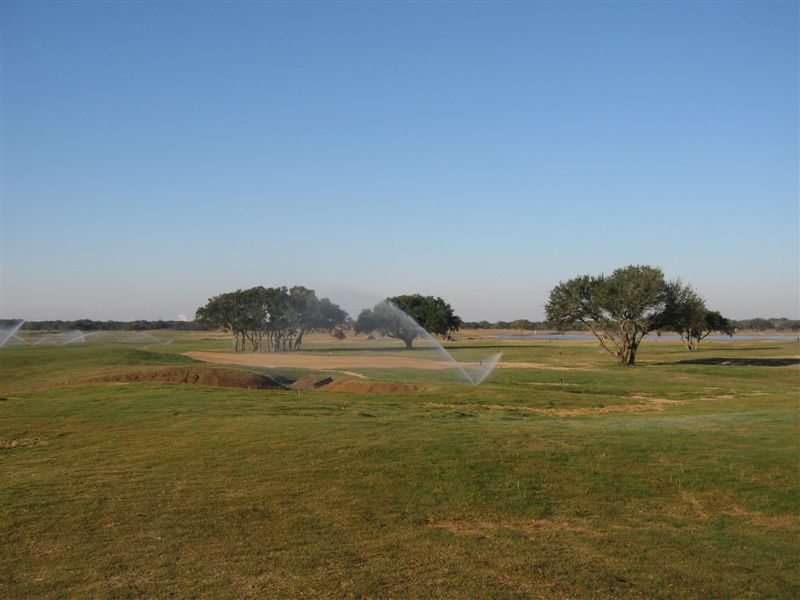
Looking from in front of the bunker. Good luck if you try to hit a wedge.
Earlier Holes Featured: 1 - 2 - 3 - 4 - 5 - 7 - 8 - 9 - 10 - 11 - 15 .
Thursday, October 25, 2007
The Club in it's earlier state
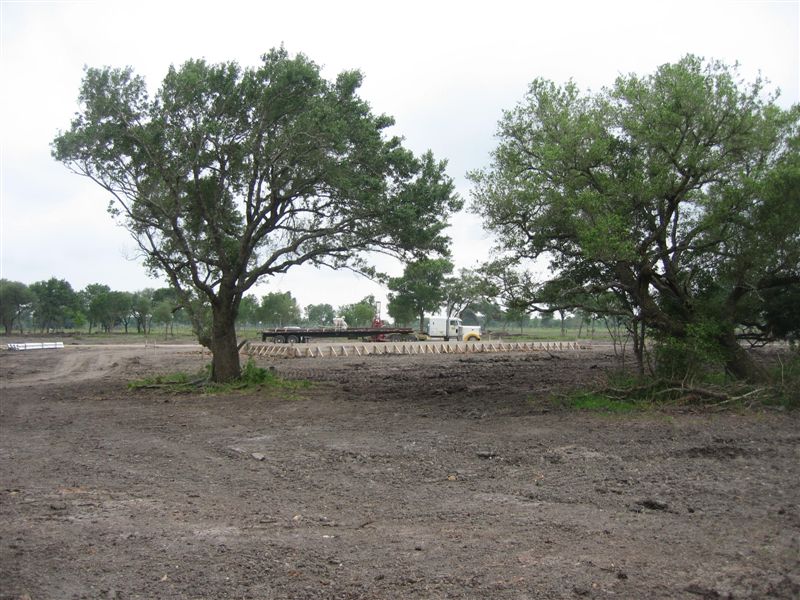 Seeing the vertical architecture progress is almost as interesting as seeing the golf course develop. Each visit I capture a few more pictures. The above image was taken early this spring, and the one below a month later. It is shaping up to be quite the club and locker room facility. I am looking forward to putting some artwork on the walls -- photography and another special piece or two. Beer on tap was Don's and my request.
Seeing the vertical architecture progress is almost as interesting as seeing the golf course develop. Each visit I capture a few more pictures. The above image was taken early this spring, and the one below a month later. It is shaping up to be quite the club and locker room facility. I am looking forward to putting some artwork on the walls -- photography and another special piece or two. Beer on tap was Don's and my request.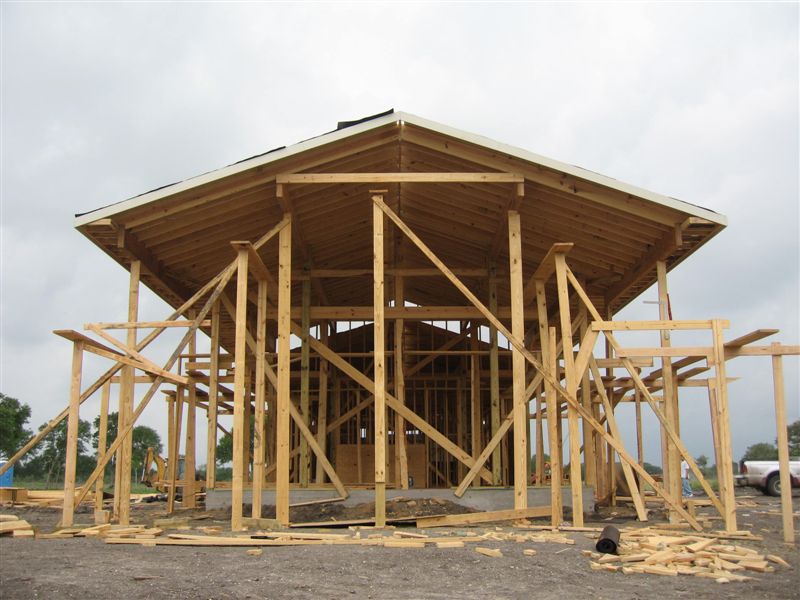 .
.Tuesday, October 23, 2007
View of the Club
Sunday, October 21, 2007
8th Tee Complex
 Back to chronicling one of my favorite or unique features of each golf hole. The 8th hole is a long par 3 almost directly into the prevailing wind. The tee complexes at Wolf Point are very subdued, small and until we start mowing are almost indiscernible from the fairways.
Back to chronicling one of my favorite or unique features of each golf hole. The 8th hole is a long par 3 almost directly into the prevailing wind. The tee complexes at Wolf Point are very subdued, small and until we start mowing are almost indiscernible from the fairways.The picture shown above if of 8th the tee complex – note the lush grass in the setting sun. The green plays to the left. The tees are an amorphous shaped landform with a few flat spot to start the hole. The foreground is being prepped for seeding of native grasses and wild flowers. The location will have more visitors due to the proximity of the club.
Earlier Holes Featured: 1 - 2 - 3 - 4 - 5 - 7 - 9 - 10 - 11 - 15 .
Friday, October 19, 2007
The Ugly Duckling
Wednesday, October 17, 2007
Interview
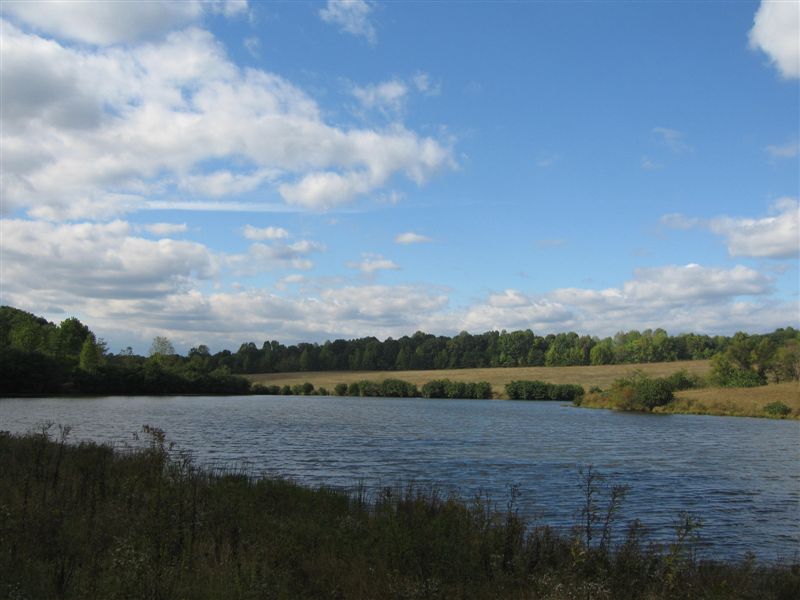 Another reason for my departure was an interview for a new golf course. Getting to know more about the clients and how I could meet their goals is for me the most important part. The client will have an impact at least as great as the land on the eventual quality of the golf course.
Another reason for my departure was an interview for a new golf course. Getting to know more about the clients and how I could meet their goals is for me the most important part. The client will have an impact at least as great as the land on the eventual quality of the golf course.I also spent two days traversing the property. It is very fun exploring a new site picturing what a golf hole and course would look like draped across the land. I also feel a bit like an explorer looking out for snakes, spiders, steep drops, hopping barb wire fences and keeping away from hunters while trying to not get lost in the woods. I think my time was very well spent -- it takes a lot of interviews and prospects for a project to emerge through the other side. I liked this one.
Tuesday, October 16, 2007
New Project Site Visit
 One of my next stops was to meet with a new client at an existing golf course. The plans are for some modest changes and the addition of a nine hole par 3 youth golf course. I’m very much looking forward to the project.
One of my next stops was to meet with a new client at an existing golf course. The plans are for some modest changes and the addition of a nine hole par 3 youth golf course. I’m very much looking forward to the project.The existing course is a little steep in spots. If it isn’t immediately apparent from the above picture, it is highly recommended to not leave your shot short on this par 3.
I’ll be back down to my Texas project this week and will have some greener pictures soon.
Monday, October 15, 2007
Exhibitor
 Aside from attending the Golf Inc. conference I was an exhibitor also – my booth is pictured above. I put a large effort into getting ready -- updated brochure, printed materials, give aways and the display itself. The display looks very good in person -- hope you can stop by at a future conference.
Aside from attending the Golf Inc. conference I was an exhibitor also – my booth is pictured above. I put a large effort into getting ready -- updated brochure, printed materials, give aways and the display itself. The display looks very good in person -- hope you can stop by at a future conference. I enjoy my time there even if everyone isn't looking for a new golf course. Meeting new -- to me -– individuals, talking to other architects and builders is a good way to share ideas. I also find the sessions quite informative, especially the financial ones.
One fun side effect from having a booth, is I greet everyone I see for several weeks afterwards. In the airport, restaurant, bar, anywhere. I’m going to try and see how long I can keep it up for…
Subscribe to:
Posts (Atom)







